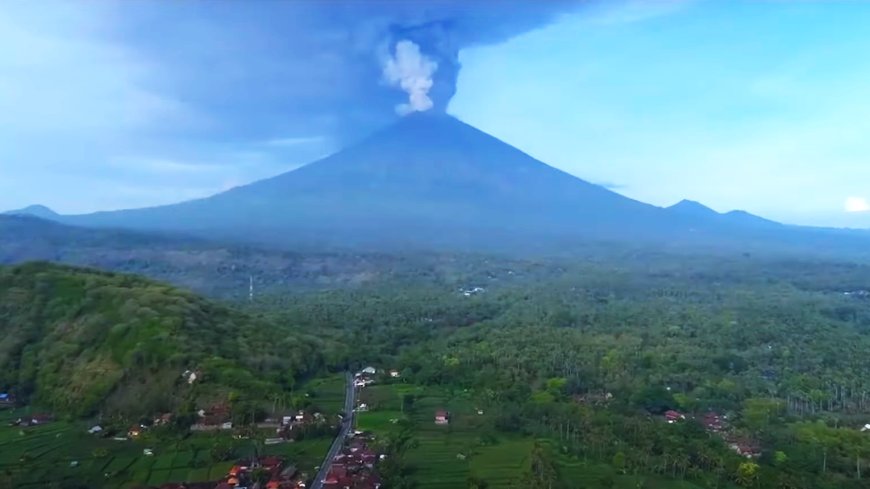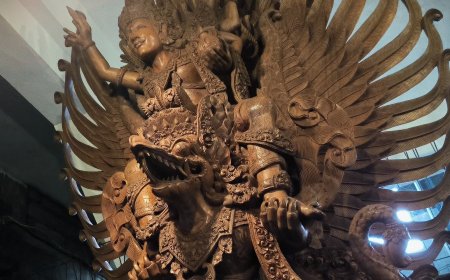Mount Agung: Sapta Linggasari, Palace of the Gods
Mount Agung, with its towering peak, stands as an icon and a spiritual symbol of the island of Bali. Not only is it one of Indonesia's tallest mountains, but it also represents a sacred site symbolizing the presence of the gods. The story of the birth of Mount Agung and the dwelling place of the gods is a legend deeply embedded in Bali's culture, rich with meaning and beauty.

In the ancient scripture "Raja Pura Sesana," there is a tale of the god Pasupati who removed the peak of Mount Mahameru in India and transported it to Java, where it became known as Mount Semeru. However, during that time, Bali Dwipa, also known as Jagat Bali, was still unstable, like a drifting boat without direction.
During this period, Bali Dwipa had only a few mountains, such as Mount Lempuyang in the east, Mount Andakasa in the south, Mount Batukaru in the west, and Mount Pucak Mangu in the north. To bring stability to Bali Dwipa, Pasupati commanded the gods to move the peak of Mount Semeru to the island.
During the process of relocation, an unexpected event occurred when a fragment of the mountain fell to the ground, forming Mount Batur. Nevertheless, the peak of Mount Semeru was successfully placed in the northeast of Bali, becoming Mount Tohlangkit, now known as Mount Agung.
At a time when Bali Dwipa had stabilized, Pasupati instructed his three sons to establish their abodes on the island. They were Dewa Hyang Gnijaya, who made his abode on Mount Lempuyang, Dewa Hyang Putranjaya, who resided on Mount Agung, and Dewi Danuh, whose dwelling was on Mount Batur.
Since then, Bali Dwipa possessed the Trilingga Giri, which consists of three mountain abodes. To complete this sacred arrangement, Pasupati commanded his other sons to establish their abodes in Bali Dwipa. These sons included Dewa Tumuwuh on Mount Watukaru, Dewa Manik Gumawang on Mount Puncak Mangu or Beratan, Dewa Manik Galang in Pejeng, and Dewa Hyang Tugu on Mount Andakasa. In addition to this, Naga Basuki was assigned to accompany Dewa Hyang Putranjaya on Mount Tohlangkir.

Mount Agung (Source: Pujangga Nagari Nusantara)
Consequently, Bali became renowned for the existence of the Sapta Linggasari, which are seven harmonious mountain abodes aligned with the teachings of upadewa as the abodes of Pasupati's sons. Hence, the Hindu community of Bali believes that Mount Agung is the dwelling place of the gods, making it a profoundly sacred and revered site.
Another legend associated with Mount Agung involves the god Indra, who is said to have dropped his magical heirloom, the "Keris Ikut Aji," on the summit of Mount Agung. It is believed that this keris possesses extraordinary powers and was used by Indra to triumph over the asuras, evil spirits. Since then, many consider this keris a sacred object symbolizing strength and protection.
Mount Agung also has a story related to Dewa Hyang Gni Jaya, who chose Mount Lempuyang as his abode. Every year, during the Galungan festival, the local community offers their respects at Pura Lempuyang Luhur to honor Dewa Hyang Gni Jaya. This serves as a testament to the enduring belief and strong cults surrounding Bali's sacred mountains.
Mount Agung not only serves as a center of Hindu worship but also reflects the close connection between religion and nature in Bali. The Balinese people believe that this mountain is one of six sacred mountains guarding the island from various directions. Alongside Mount Agung, other mountains like Mount Batur, Mount Lempuyang, and Mount Batukaru are considered to possess spiritual power and symbolize protection for Bali. This exemplifies how the Balinese people seamlessly integrate their spiritual beliefs with the enchanting natural landscapes.

Mount Agung (Source: Pujangga Nagari Nusantara)
Mount Agung and Pura Besakih share a very close relationship in Balinese culture and belief. Pura Besakih, also known as Pura Agung Besakih, is one of the holiest temples in Bali and is located on the slopes of Mount Agung. The existence of this temple creates a strong visual connection with this sacred mountain, making it a profoundly meaningful place for the Balinese people.
Pura Besakih is believed to be a "shelter" for the gods residing on Mount Agung. Therefore, this temple plays a crucial role in various Hindu religious ceremonies in Bali. Located in the center of the expansive temple complex, Pura Penataran Agung Besakih is the main temple and is considered the "mother temple" representing the entire complex.
The relationship between Mount Agung and Pura Besakih creates a harmonious unity between nature and human spirituality in Bali. Through religious ceremonies, offerings, and other rituals, Mount Agung and Pura Besakih play a vital role in maintaining the harmony of culture and spirituality in Balinese society. They reflect a deep belief in the protection and blessings of the gods and the close connection between nature and daily life.
The presence of Pura Besakih on the slopes of Mount Agung also reflects a deep belief in the protection and blessings of the gods in preserving the environment and daily life in Bali. Pura Besakih is one of the clearest examples of how Balinese Hindu religious beliefs and the island's natural wealth are interconnected and reinforce each other. In the broader cultural and spiritual context of Bali, Mount Agung and Pura Besakih remain fascinating and inspiring focal points for the local residents and the tourists who come to experience them.
Mount Agung is not just a magnificent natural monument in Bali, it is also a symbol of belief, culture, and the island's identity. The legendary stories associated with this mountain reveal a deep spiritual heritage and the commitment of the Balinese people to preserve the surrounding environment. Through the integration of nature and religion, Mount Agung continues to be a source of inspiration and awe for those who come to experience it.





























































